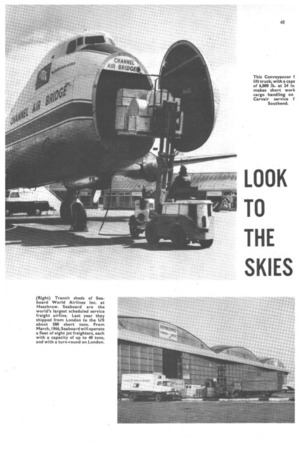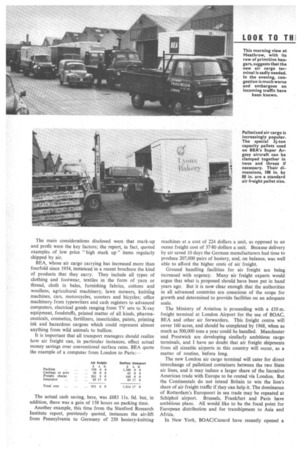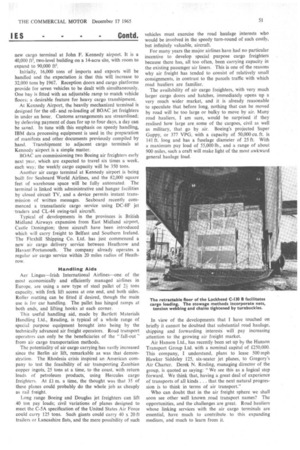LOOK TO THE SKIES
Page 50

Page 51

Page 52

Page 53

If you've noticed an error in this article please click here to report it so we can fix it.
BECAUSE most transport men are specialists, technical development in their branch of transport is normally of wide interest to them. Most operators are pretty knowledgeable about new types of vehicle or improved operating techniques which are open to them.
Some developments, such as the introduction of road ferry services, enable much wider operating concepts to be considered; established road haulage firms, for example, who sent the odd vehicle to the Continent in a spirit of bold pioneering, found it so pleasing that their operations are now oriented to Continental freight movement.
A similar development, I believe, is that of air cargo, in which few road hauliers take interest although it offers remarkable possibilities of growth. By comparison with anything it has done in its previous history, air freight is today enjoying a boom. Yet the industry confidently expects its rapid growth rate to continue for the foreseeable future.
Why is air freight booming? There are many reasons, but if one is more important than all others, it is that the Western world is getting richer. Particularly is this so in America, where family incomes have increased vastly in the past 20 years. This trend is likely to continue, and with it a demand for higher-quality, higher-priced goods. No one pretends that air freight is a cheap method of transport, judged on price alone; but the existence of affluent Western societies in North America and to a lesser extent elsewhere, explains why air freight will play an increasing part in the transport of goods in the future. British exports worth £650m. were moved by air in 1964. That sizeable sum, it is true, represents only 7% of our total trade, but air cargo traffic on the North Atlantic route is growing by something like 60% annually, and other routes show a marked upward trend.
Since 1949, air freight moved by member states of the I.C.A.O. (world airlines conference) has risen from 500,000 ton miles to nearly 3,000 million ton miles in 1964. These astronomical sounding figures can be made more comprehensible by looking at the tonnage carried on a single route for one year, 1964. Then, all airlines on the North Atlantic route carried 133,000 short tons (a short ton is 2,000 lb.) a figure which excludes mail carried. Of this, 130AC carried 12,200 short tons, less than half the load carried by the giant Pan American Airways.
The air lines (and air shipping agencies that "drum up" a large volume of air freight) have developed in recent years some sophisticated publicity to persuade industrialists, and their transport managers, to send goods by air. Typical of this approach was a 177-page research report "How to Identify Potential Company Uses of Air Freight ", compiled by Stanford Research Institute, California under the sponsorship of Emery Air Freight, a forwarding organization.
The report, which achieved international recognition, stressed that transport cost alone should not determine policy. Savings in packing, insurance, and warehousing must be included with the obvious speed advantage of air freight for the total advantage to be assessed. The report set out in great detail the less obvious advantages whereby air forwarding could give an edge to sales promotion, and reduce stock holdings and, in particular, it refuted the long-persistent idea that air freight was only suitable for goods of high intrinsic value. The main considerations disclosed were that mark-up and profit were the key factors; the report, in fact, quoted examples of low price "high mark up" items regularly shipped by air.
BEA, whose air cargo carrying has increased more than fourfold since 1954, instanced in a recent brochure the kind of products that they carry. They include all types of clothing and footwear, textiles in the form of yarn or thread, cloth in bales, furnishing fabrics, cottons and woollens, agricultural machinery, lawn mowers, knitting machines, cars, motorcycles, scooters and bicycles; office machinery from typewriters and cash registers to advanced computers, electrical goods ranging from TV sets to X-ray equipment, foodstuffs, printed matter of all kinds, pharmaceuticals, cosmetics, fertilizers, insecticides, paints, printing ink and hazardous cargoes which could represent almost anything from wild animals to bullion.
It is important that all transport managers should realize how air freight can, in particular instances, effect actual money savings over conventional surface rates. BEA quote the example of a computer from London to Paris:— The actual cash saving, here, was £683 1 ls. Od. but, in addition, there was a gain of 158 hours on packing time.
Another example, this time from the Stanford Research Institute report, previously quoted, instances the air-lift from Pennsylvania to Germany of 230 hosiery-knitting machines at a cost of 224 dollars a unit, as opposed to an ocean freight cost of 37.80 dollars a unit. Because delivery by air saved 10 days the German manufacturers had time to produce 207,000 pairs of hosiery, and, on balance, was well able to afford the higher costs of air freight.
Ground handling facilities for air freight are being increased with urgency. Many air freight experts would argue that what is proposed should have been put in hand years ago. But it is now clear enough that the authorities in all advanced countries are conscious of the scope for growth and determined to provide facilities on an adequate scale.
The Ministry of Aviation is proceeding with a £10 m. freight terminal at London Airport for the use of BOAC, BEA and other air forwarders. This freight centre will cover 160 acres, and should be completed by 1968, when as much as 500,000 tons a year could be handled. Manchester and Prestwick are developing similarly ambitious cargo terminals, and I have no doubt that air freight shipments from all sizeable airports in this country will occur, as a matter of routine, before long.
The new London air cargo terminal will cater for direct interchange of palletized containers between the two State air lines, and it may induce a larger share of the lucrative American trade with Europe to be routed via London. But the Continentals do not intend Britain to win the lion's share of air freight traffic if, they can help it. The dominance of Rotterdam's Europoort in sea trade may be repeated at Schiphol airport. Brussels, Frankfurt and Paris have ambitious plans. All would like to be the focal point for European distribution and for transhipment to Asia and Afriea.
In New York, BOAC/Cunard have recently opened a new cargo terminal at John F. Kennedy airport. It is a 40,000 ft', two-level building on a 14-acre site, with room to expand to 90,000 ft'.
Initially, 16,000 tons of imports and exports will be handled and the expectation is that this will increase to 32,000 tons by 1967. Reception doors and cargo platforms provide for seven vehicles to be dealt with simultaneously. One bay is fitted with an adjustable ramp to match vehicle floors; a desirable feature for heavy cargo transhipment.
At Kennedy Airport, the heavily mechanized terminal is designed for the offand re-loading of BOAC jet freighters in under an hour. Customs arrangements are streamlined; by deferring payment of dues for up to four days, a day can be saved. In tune with this emphasis on speedy handling, IBM data processing equipment is used in the preparation of manifests and other documents previously compiled by hand. Transhipment to adjacent cargo terminals at Kennedy airport is a simple matter.
BOAC are commissioning two Boeing air freighters early next year, which 4re expected to travel six times a week, each way; the weekly. cargo capacity will be 350 tons.
Another air cargo terminal at Kennedy airport is being built for Seaboard World Airlines, and the 82,000 square feet of warehouse space will be fully automated. The terminal is linked with administrative and hangar facilities by closed circuit TV, and a device permits instant transmission of written messages. Seaboard recently commenced a transatlantic cargo service using DC-8F jet -traders and CL-44 swing-tail aircraft.
Typical of developments in the provinces is British Midland Airways expansion from East Midland airport, Castle Donington; three aircraft have been introduced which will carry freight to Belfast and Southern Ireland. The Flexhill Shipping Co. Ltd. has just commenced a new air cargo delivery service between Heathrow and Havant;Portsmouth. The company already operates a regular air cargo service within 20 miles radius of Heathrow.
Handling Aids
Aer Lingus—Irish International Airlines—one of the most economically and efficiently managed airlines in Europe, are using a new type of steel pallet of 2+ tons capacity, with fork lift access at one end, and both sides. Roller matting can be fitted if desired, though the main use is for car handling. The pallet has hinged ramps at both ends, and lifting hooks at each corner.
This useful handling aid, made by Bartlett Materials Handling Ltd., Reading, is typical of a whole range of special purpose equipment brought into being by the technically advanced air freight operators. Road transport operators can only be the beneficiaries of the "fall-out' from air cargo transportation methods.
The potentiality of air cargo carrying has vastly increased since the Berlin air lift, remarkable as was that demonstration. The Rhodesia crisis inspired an American company to test the feasibility of air transporting Zambian copper ingots, '25 tons at a time, to the coast, with return loads of petroleum products, using Hercules cargo freighters. At £1 m. a time, the thought was that 35 of these planes could probably do the whole job as cheaply as rail freight.
Long range Boeing and Douglas jet freighters can lift 40 ton pay loads; civil variations of planes designed to meet the C-5A specification of the United States Air Force could carry 125 tons. Such giants could carry 40 x 20 ft trailers or Lancashire -flats, and the mere possibility of such vehicles must exercise the road haulage interests who would be involved in the speedy turn-round of such costly, but infinitely valuable, aircraft.
For many years the major airlines have had no particular incentive to develop special purpose cargo freighters because there has, all too often, been carrying capacity in the existing passenger air liners. This is one of the reasons why air freight has tended to consist of relatively small consignments, in contrast to the parcels traffic with which road hauliers are familiar.
The availability of air cargo freighters, with very much larger cargo doors and hatches, immediately opens up a very much wider market, and it is already reasonable to speculate that before long, nothing that can be moved by road will be too large or bulky to move by air. Many road hauliers, I am sure, would be surprised if they .realised how large are some of the cargoes, civil as well as military, that go by air. Boeing's projected Super Guppy, or 377 VPG, with a capacity of 50,000 cu. ft. is 141 ft. long and has a fuselage diameter of 25 ft. With a maximum pay load of 55,000 lb., and a range of about 900 miles, such a craft will make light of the most awkward general haulage load.
In view of the developments that I have touched on briefly it cannot be doubted that substantial road haulage, shipping and forwarding interests will pay increasing attention to the growing air freight market.
Air Hanson Ltd., has recently been set up by the Hanson Transport Group Ltd. with a nominal capital of £250,000. This company, I understand, plans to lease 500 mph Hawker Siddeley 125, six-seater jet planes, to Gregory's Air Charter. Derek N. Rosling, managing director of the group, is quoted as saying: " We see this as alogical step forward. We think that, having a great deal of experience of transports of all kinds . . . that the next natural progression is to think in terms of air transport."
Who can doubt that in the air freight sphere we shall soon see other well known ,road transport names? The opportunities, and the challenges are great. Road hauliers whose linking services with the air cargo terminals are essential, have much to contribute to this expanding medium, and much to learn from it.












































































































